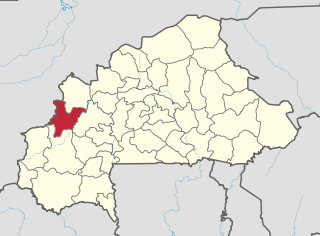
(120178) 2003 OP32, also written as (120178) 2003 OP32, is a trans-Neptunian object (TNO) that resides in the Kuiper belt. It was discovered on July 26, 2003 by Michael E. Brown, Chad Trujillo and David L. Rabinowitz at Palomar Mountain in California.

(145453) 2005 RR43, also written as (145453) 2005 RR43, is a trans-Neptunian object (TNO) estimated to be about 250 km in diameter. It was discovered on 9 September 2005 by Andrew Becker, Andrew Puckett and Jeremy Kubica at Apache Point Observatory in Sunspot, New Mexico. It is possibly a dwarf planet.
888 is the natural number following 887 and preceding 889.
Dima is a village in the Sami Department of Banwa Province in western Burkina Faso. As of 2005 it had a population of 489.
Bayé is a town in the Solenzo Department of Banwa Province in western Burkina Faso. As of 2005 it had a population of 5,478.
Denkoro is a town in the Solenzo Department of Banwa Province in western Burkina Faso. As of 2005 it had a population of 2,490.
Dira is a town in the Solenzo Department of Banwa Province in western Burkina Faso. As of 2005 it had a population of 3,209.
Dissankuy is a town in the Solenzo Department of Banwa Province in western Burkina Faso. As of 2005 it had a population of 2,794.
Kiè is a town in the Solenzo Department of Banwa Province in western Burkina Faso. As of 2005 it had a population of 6,212.
Lèkoro is a town in the Solenzo Department of Banwa Province in western Burkina Faso. As of 2005 it had a population of 1,668.
Masso is a town in the Solenzo Department of Banwa Province in western Burkina Faso. As of 2005 it had a population of 2,465.

Mawé is a town in the Solenzo Department of Banwa Province in western Burkina Faso. As of 2005 it had a population of 2,329.
Moussakongo is a town in the Solenzo Department of Banwa Province in western Burkina Faso. As of 2005 it had a population of 3,310.

Ben is a village in the Tansila Department of Banwa Province in western Burkina Faso. As of 2005 it had a population of 901. It lies near the border with Mali.
Tansila is a town and seat of the Tansila Department of Banwa Province in western Burkina Faso. In 2005 it had a population of 3,876.
Nangouna is a town in the Tansila Department of Banwa Province in western Burkina Faso. As of 2005 it had a population of 1,483.
Toma is a town in the Tansila Department of Banwa Province in western Burkina Faso. As of 2005 it had a population of 1,459.
XO-3 is a star in the constellation Camelopardalis. The star has a magnitude of 10 and is not visible to the naked eye but is visible through a small telescope. A search for a binary companion star using adaptive optics at the MMT Observatory was negative.
Tameside College is a further education college located in Ashton-under-Lyne, Greater Manchester, England.

DIMP, or N-(3,5-dimethyl-4-isoxazolylmethyl)phthalimide, is a nonsteroidal antiandrogen (NSAA) structurally related to thalidomide that was first described in 1973 and was never marketed. Along with flutamide, it was one of the earliest NSAAs to be discovered, and for this reason, has been described as a "classical" NSAA. The drug is a selective, competitive, silent antagonist of the AR, although it is described as an "only relatively weak competitor". Its relative binding affinity for the androgen receptor is about 2.6% of that of metribolone. DIMP possesses no androgenic, estrogenic, progestogenic, or antigonadotropic activity, but it does reverse the antigonadotropic effects of testosterone, indicating that, like other pure AR antagonists, it is progonadotropic.







